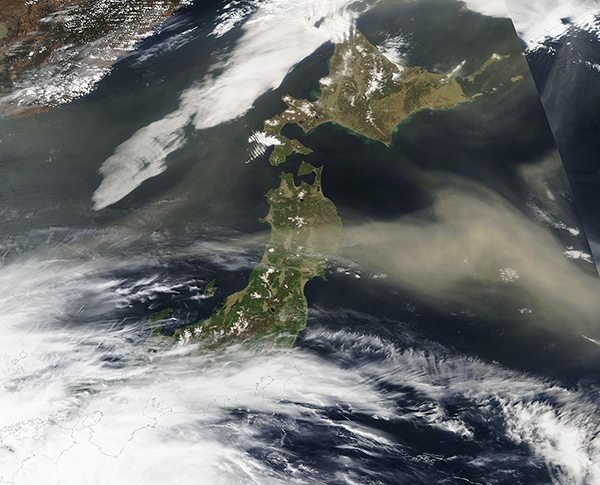Images
May 1, 2024 - Dust over Japan
Tweet
In East Asia, the arrival of spring means warming temperatures, greening vegetation, and blooming flowers. But March and April also bring another guest: vast plumes of dust that stream east from the Gobi and Taklamakan deserts and across parts of eastern China, the Korean Peninsula, and southern Japan.
The MODIS (Moderate Resolution Imaging Spectroradiometer) sensor on NASA’s Aqua satellite captured this true-color image a massive plume of dust covering part of northern Honshu island, Japan and the North Pacific Ocean on April 26, 2024.
The source of the dust most likely was the Gobi Desert of Inner Mongolia. Earlier MODIS images show a wall of dust along stretching along the coastal Korean Peninsula on April 25 and a low-pressure system in the Sea of Japan (East Sea). The storm system would have provided strong winds necessary to sweep large amounts of desert dust long distances.
NASA researchers have picked up on some changes in dust activity in the Gobi and Taklamakan deserts. A past analysis of nearly two decades of data from the Terra and Aqua satellites found that this was the only region in the world where levels of atmospheric dust have declined since the start of the study period in 2003.
The reasons for this decline are unclear, but it is likely related to the weakening of surface winds since 2001, according to one analysis, published in November 2022 in the journal Nature Communications. Other research has emphasized land management and greening of the landscape as being important factors.
Image Facts
Satellite:
Aqua
Date Acquired: 4/26/2024
Resolutions:
1km (1.5 MB), 500m (4.1 MB), 250m (2.4 MB)
Bands Used: 1,4,3
Image Credit:
MODIS Land Rapid Response Team, NASA GSFC
Tweet
In East Asia, the arrival of spring means warming temperatures, greening vegetation, and blooming flowers. But March and April also bring another guest: vast plumes of dust that stream east from the Gobi and Taklamakan deserts and across parts of eastern China, the Korean Peninsula, and southern Japan.
The MODIS (Moderate Resolution Imaging Spectroradiometer) sensor on NASA’s Aqua satellite captured this true-color image a massive plume of dust covering part of northern Honshu island, Japan and the North Pacific Ocean on April 26, 2024.
The source of the dust most likely was the Gobi Desert of Inner Mongolia. Earlier MODIS images show a wall of dust along stretching along the coastal Korean Peninsula on April 25 and a low-pressure system in the Sea of Japan (East Sea). The storm system would have provided strong winds necessary to sweep large amounts of desert dust long distances.
NASA researchers have picked up on some changes in dust activity in the Gobi and Taklamakan deserts. A past analysis of nearly two decades of data from the Terra and Aqua satellites found that this was the only region in the world where levels of atmospheric dust have declined since the start of the study period in 2003.
The reasons for this decline are unclear, but it is likely related to the weakening of surface winds since 2001, according to one analysis, published in November 2022 in the journal Nature Communications. Other research has emphasized land management and greening of the landscape as being important factors.
Image Facts
Satellite:
Aqua
Date Acquired: 4/26/2024
Resolutions:
1km (1.5 MB), 500m (4.1 MB), 250m (2.4 MB)
Bands Used: 1,4,3
Image Credit:
MODIS Land Rapid Response Team, NASA GSFC




